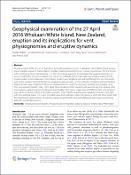Options
Geophysical examination of the 27 April 2016 Whakaari/White Island, New Zealand, eruption and its implications for vent physiognomies and eruptive dynamics
Author(s)
Date Issued
2019-02-28
Date Available
2019-08-20T12:38:22Z
Abstract
At approximately 09:36 UTC on 27 April 2016, a phreatic eruption occurred on Whakaari Island (White Island) producing an eruption sequence that contained multiple eruptive pulses determined to have occurred over the first 30 min, with a continuing tremor signal lasting ~ 2 h after the pulsing sequence. To investigate the eruption dynamics, we used a combination of cross-correlation and coherence methods with acoustic data. To estimate locations for the eruptive pulses, seismic data were collected and eruption vent locations were inferred through the use of an amplitude source location method. We also investigated volcanic acoustic–seismic ratios for comparing inferred initiation depths of each pulse. Initial results show vent locations for the eruptive pulses were found to have possibly come from two separate locations only ~ 50 m apart. These results compare favorably with acoustic lag time analysis. After error analysis, eruption sources are shown to conceivably come from a single vent, and differences in vent locations may not be constrained. Both vent location scenarios show that the eruption pulses gradually increase in strength with time, and that pulses 1, 3, 4, and 5 possibly came from a deeper source than pulses 2 and 6. We show herein that the characteristics and locations of volcanic eruptions can be better understood through joint analysis combining data from several data sources.
Type of Material
Journal Article
Publisher
Springer Nature
Journal
Earth, Planets and Space
Volume
71
Issue
1
Start Page
25
Copyright (Published Version)
2019 the Authors
Language
English
Status of Item
Peer reviewed
ISSN
1343-8832
This item is made available under a Creative Commons License
File(s)
Loading...
Name
10.1186_s40623-019-1003-0.pdf
Size
16.41 MB
Format
Adobe PDF
Checksum (MD5)
593155bfc44559f095099a693ed03a31
Owning collection